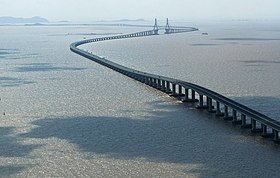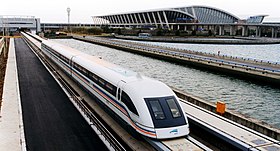Transport in China
This articleneeds additional citations forverification.(January 2021) |
Transport inChinahas experienced major growth and expansion in recent years. Although China's transport system comprises a vast network of transport nodes across its huge territory, the nodes tend to concentrate in the more economically developed coastal areas and inland cities along major rivers.[1]The physical state and comprehensiveness of China's transport infrastructure tend to vary widely bygeography.While remote, rural areas still largely depend on non-mechanized means of transport, urban areas boast a wide variety of modern options, including amaglevsystem connecting the city center ofShanghaiwithShanghai Pudong International Airport.Airports, roads, and railway construction will provide a massive employment boost in China over the next decade.
Much of contemporary China's transport systems have been built since the establishment of the People's Republic in 1949. Therailway,which is the primary mode of long distancetransport,has seen rapid growth reaching 139,000 km (86,371 mi) of railway lines making it the second longest network in the world (2016).[2][3]Prior to 1950, there were only 21,800 km (13,546 mi) of railway lines. The extensive rail network includes thelongest and busiest HSR network in the worldwith 35,000 km (21,748 mi) ofhigh-speed linesby year end 2019.[4][3]While rail travel remained the most popular form of intercity transport, air travel has also experienced significant growth since the late 1990s. Major airports such asBeijing Capital InternationalandShanghai Pudong Internationalbeing among the busiest in the world. At the end of 2017,[5]there are some 34metrosystems in operation across China, including some of the largest and busiest subway networks in the world. Of the 12 largest metro networks in the world by length,seven are nowin China.[6]Additionally, manybus rapid transit,light railandrapid transitlines are currently under construction, or in the planning stages across the country. Thehighwayandroadsystem also has gone through rapid expansion, resulting in a rapid increase ofmotor vehicleuse throughout China. A government-led effort started in the 90s to connect the country by expressways via theNational Trunk Highway Systemhas expanded the network to about 97,000 km (60,273 mi) by the end of 2012[7]making China's the longest expressway network in the world.
History
[edit]China is in the midst of a massive upgrade of itstransportinfrastructure.Until recently, China's economy was able to continue to grow despite deficiencies in infrastructure development. This is no longer the case, and the government realizes that to keep the economy moving forward, they need an efficient system in place to move goods and people across the country. According toWorld Bankstatistics, goods lost due to poor or obsolete transport infrastructure amounted to one percent of China's GDP as recently as the most current survey (mid-1990s).Logisticcosts account for 20% of a product's price in China, compared to 10% in theUnited States,and 5% in other developed countries.
Portsare being improved for greater use of China'swaterways,andairportsare being improved across the country. Related industries such as construction equipment, engineering, container security, and electronics and safety devices have also grown rapidly.
Regulation
[edit]Mainland China
[edit]Transport in mainland China is regulated by a new agency formed from theMinistry of Transport,theMinistry of Railways,theCivil Aviation Administration of China.
Special administrative regions
[edit]The aforementioned transport authorities have nojurisdictioninHong KongandMacau.Hong Kong's transport is regulated by theTransport Department of Hong Kong,whereas Macau's transport is regulated by the Transport Bureau of Macau.[8]
Rail
[edit]
Rail is the major mode of transport in China. In 2019, railways in China delivered 3.660 billion passenger trips, generating 1,470.66 billion passenger-kilometres and carried 4.389 billion tonnes of freight, generating 3,018 billion cargo tonne-kilometres;[9]both traffic volumes are among the highest in the world. The high volume of traffic that China's railway system carries makes it critical to China'seconomy.China's railway system carries 24% of the world's railway transport volume on only 6% of the world's railways. China has the world's second longest railway network; as of 2020 it is 146,300 km (90,907 mi) long.[10]About 71.9% of the network is electrified in 2019.[9]
In 2011 China's railway inventory included 19,431locomotives[11]owned by the national railway system. The inventory in recent times included some 100steam locomotives,but the last such locomotive, built in 1999, is now in service as atourist attractionwhile the others have been retired from commercial service. The remaining locomotives are eitherdiesel- orelectric-powered. Another 352 locomotives are owned by local railroads and 604 operated byjoint-venturerailways. National railway freight cars numbered 622,284[11]and passenger coaches 52,130 .[11]
Because of its limited capital, overburdened infrastructure, and need to continuously modernize, the national rail system, which is controlled by theMinistry of Railwaysthrough a network of regional divisions, operates on an austerebudget.Foreign capitalinvestmentin thefreightsector was allowed beginning in 2003, and international public stock offerings opened in 2006. In another move to better capitalize and reform the rail system, the Ministry of Railways established three public shareholder-owned companies in 2003: China Railways Container Transport Company, China Railway Special Cargo Service Company, and China Railways Parcel Express Company.
In recent decades, rail use in China has seen significant growth in the volume of goods and passengers transported. Since 1980, the volume of goods transported (metric tons times kilometers traveled) has increased by 305% and the volume of passengers (million passengers times kilometers traveled) has increased by 485%.[12]During this same time period, total length of rail lines has only increased by 34%.[12]
| 1980 | 1990 | 2000 | 2010 | 2014 | 2015 | 2017 | |
|---|---|---|---|---|---|---|---|
| Rail lines (total route-km)[13] | 49,940 | 53,378 | 58,656 | 66,239 | 66,989 | ||
| Goods transported on railways (metric tons times kilometers traveled) | 570,732 | 1,060,100 | 1,333,606 | 2,451,185 | 2,308,669 | ||
| Passengers carried on railways (million passengers times kilometers traveled) | 138,037 | 263,530 | 441,468 | 791,158 | 807,065 | ||
| Urban rail transit (kilometers)[5] | 5,033 | ||||||
| Subway (kilometers)[5] | 3,844 | ||||||
| Urban rail transit under construction (kilometers)[5] | 6,246 | ||||||
| Bus rapid transit(kilometers)[14] | 2,991 |
Regional development
[edit]
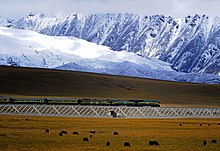
In 1992, a new large-scale rail project was launched in China, called the "New Silk Road" or "Eurasian Continental Bridge" project. The project involved the modernization and infrastructure development of a 4,131 km (2,567 mi) railroad route starting inLianyungang,Jiangsu,and traveling through central and northwestern China toUrumqi,Xin gian g,to theAlataw PassintoKazakhstan.From that point, the railroad links to some 6,800 km (4,225 mi) of routes that end inRotterdam.
China also has established rail links between seaports and interior export-processing zones. For example, in 2004ChengduinSichuanwas linked to theShenzhen Special Economic Zonein coastalGuangdong;exports clearcustomsin Chengdu and are shipped twice daily by rail to the seaport atShenzhenfor fast delivery.
Tibet
[edit]A 1,080 km (671 mi) section of theQingzang railwayhas been completed fromGolmudtoLhasa.The 815 km (506 mi) section fromXiningto Golmud inQinghaiopened to traffic in 1984. The railway's highest point, theTanggula Mountain Pass,is 5,072 m above sea level, making it the highest railway in the world. More than 960 km (597 mi), or over four-fifths of the railway, is at an altitude of more than 4,000 m, and over half of it was laid on frozen earth. Because of the high altitudes, carriages are supplied with supplementaloxygen.
LinkingLhasaandShigatsetogether inTibet,the construction of a 254 km (158 mi) extension line of theQingzang railwaystarted in 2009 with completion expected by 2014.
High-speed rail
[edit]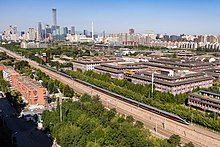
The high-speed service is mainly operated byChina Railway High-speed.HSR developed rapidly in China over the past 15 years thanks to generous funding from the Chinese government. With ridership exceeding 1.44 billion in 2016, China's HSR service was the most heavily used in the world.[15][16]In 2016, the network is thelongest in the worldand accounted for about two-thirds of the world's high-speed rail tracks[17]and operated with 2,595 high-speed trains, accounting for about 60 percent of all global high-speed trains.[18][needs update]
Maglev
[edit]China also has the world's first commercial high-speed maglev (magnetic levitation) service,Shanghai Maglev Train(the first maglev service opened at Birmingham International Airport, United Kingdom, in 1984; however, it was not high-speed). The Chinese project, a Sino-German joint venture, was a 38-km-long route between downtownShanghaiand thePudong airportthat opened in 2003. The project cost US$1.2 billion.[19]Low speed commuter maglevs using ingenious technology have opened in Changsha (Changsha Maglev) and Beijing (Line S1, Beijing Subway).
In January 2021 a prototype for a new high-speed maglev train capable of 620 km/h (390 mph) was unveiled. Developed bySouthwest Jiaotong Universitynear Chengdu, Professor He Chuan, vice president of the university, told reporters that the train is scheduled to be operational within 3–10 years.[20]In July 2021 theCRRCunveiled a four-car 600 km/h (370 mph) maglev train.[21]Long test tracks are being developed to test the vehicles.
Railway links with adjoining countries
[edit]The two railway links China have with a neighboring country that does not have abreak of gaugeis withNorth KoreaandVietnam.China also has links withKazakhstan,MongoliaandRussia,which all use the1,520 mm(4 ft11+27⁄32in) gauge, and withVietnam,where the1,000 mm(3 ft3+3⁄8in) gauge is still in use. TheTrans-Siberian Railway,which crossesRussia,has a branch that sweeps down fromUlan-Ude,acrossMongolia,and on toBeijing.
China does not have a direct rail link withAfghanistan,Bhutan,India,Kyrgyzstan,Nepal,PakistanorTajikistan,but is currently planning links withLaosandIndia(viaMyanmar).
Variable-gauge-axletrains are sometimes used to overcome thebreak of gaugewith neighboring countries. The mainland is also linked toHong Kong,but not withMacau,although a Macau link is planned.
Urban Rail
[edit]Rapid Transit
[edit]
Currently there over 30 rapid transit systems in mainland China. A further 12 systems are under construction and 20 more metros are planned. Today China boasts the world'slongest,secondandthird longestmetro systems.[22][23][24]TheShanghai Metroonly started operating in 1993 and has since expanded to be the world's longest subway system.[22][23][25]Of the top 15 longest metro systems in the world 8 of them are in China, also possessing half of the top ten busiest metro systems in the world.[26]As of January 2016, 39 cities have metro systems approved according to the National Development and Reform Commission. China plans to spend 4.7 trillion yuan ($706 billion) on transport infrastructure in the three years following 2016.[27]As of early 2017, China has 5636.5 km of under construction rail transit lines.[28]


Light Rail/Tram
[edit]Several cities in China had tram systems during the 20th century; however, by the end of the century, onlyDalian,Hong KongandChangchunremained. Since 2010, then new tram systems opened inQingdao,Guangzhou,Shenzhen,Shenyang,Suzhou,Zhuhai,andHuai'an.

onIsland line, MTR
In 2016 a Chinese firm developed theAutonomous Rail Rapid Transitsystem which has been described as a crossover between atrain,abusand atramand is commonly called a "trackless tram".[29]As of 2021 the system has four lines in operation and is being considered for a number of other locations around the country.
Monorail
[edit]China has installed a number of straddle-type rubber-tyred monorail systems since 2005. The longest monorail line in the world, at 66.2 km (41.1 mi), isLine 3located inChongqing.A large number of other transit systems are under construction, as well as tourist lines usingsuspended monorailtechnology.
Suburban and commuter rail systems
[edit]China's passenger railways are mostly used for medium- and long-distance travel, with few trains stopping anywhere but at major stations in center cities.Commuter railsystems, characteristic of large European and North American cities, were initially uncommon in China. Instead radial suburban metro lines (Shanghai Metro Line 16,Binhai Mass Transit Line 9,Guangfo Metro,etc.) were mostly fulfilling that role. However a number of high-speed regional networks such as theChengdu–Du gian gyan ICR,Changsha–Zhuzhou–Xiangtan ICR,Pearl River Delta Rapid Transit,andWuhan Metropolitan Area Intercity Railwayhave recently started providing commuter services.
Rail Transit in the special administrative regions
[edit]Hong KongMass Transit Railwaywas planned, designed, constructed and opened underBritish administration;it was opened in 1979 and merged with the KCR network in 2007 to form a 10-line heavy metro operation and a modernlight railnetwork. In addition, atramwaysystem operates onHong Kong Island.
The Macau LRT was first proposed in 2003, but a final go-ahead was not given until a public announcement by the Government of Macau in October 2006. The Macau Light Transit System will serve the Macau Peninsula, Taipa island, Cotai reclamation area and Macau International Airport.
Road
[edit]Motor vehicles
[edit]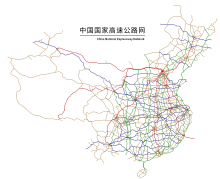


During the war withJapan,in the 1930s, China built many roads, the most famous of which is theBurma Roadthat leads southwest fromKunmingto the city ofLashio.Since it came into power, the Communist government initiated a large effort into building highways that extend across China and beyond its borders.
Today, China is linked by an evolving network of highways (China National Highways) and expressways (Expressways of China). In the past few years, China has been rapidly developing its road network. Between 1990 and 2003, the total length of urban roads in China more than doubled; increasing from 95,000 to 208,000 kilometers of roads during that period. Similarly, during the same period of time, the total area allocated to roads more than tripled; from 892 million square meters in 1990, to 3,156.5 million square meters in 2003.[30]China National Highways stretch to all four corners of mainland China. Expressways reach the same destinations asChina National Highways,except for the rugged terrain of Tibet. An expressway link is already at the planning stage.
Highways (totaling 130,000 km) were critical to China's economic growth as it worked to mitigate a poor distribution network and authorities sought to spur economic activity directly. The highway and road systems carried nearly 11.6 billion tons of freight and 769.6 trillion passenger/kilometers in 2003.
The importance ofhighwaysandmotor vehicles,which carry 13.5% of cargo and 49.1% of passengers, was growing rapidly in the mid-2000s.Automobileusage has increased significantly in urban areas as incomes rise. However, car ownership is still low in comparison to the other members of theBRICgroup of countries, being exceeded byRussiaandBrazil.[31]Indeed, the rate of car ownership in China is only expected to meet the 1960s level of car ownership of some developed countries in 2015.[32]
In 2002, excluding military and probably internal security vehicles, there were 12 million passenger cars and buses in operation and 8.1 million other vehicles. In 2003 China reported that 23.8 million vehicles were used for business purposes, including 14.8 million passenger vehicles and 8.5 million trucks. The latest statistics from the Beijing Municipal Statistics Bureau show that Beijing had nearly 1.3 million privately owned cars at the end of 2004 or 11 for each 100 Beijing residents. Beijing currently has the highest annual rate of private car growth in China, leading to major congestion in the capital.
In 2005 China had a total road network of more than 3.3 million km, although approximately 1.47 million km of this network are classified as "village roads". Paved roads totaled 770,265 km (478,620 mi) in 2004; the remainder were gravel, improved earth standard, or merely earth tracks.
Some 270,000 km (167,770 mi) of rural highways will be built and upgraded in 2008. By comparison, 423,000 km (262,840 mi) of countryside highways were built or upgraded in 2007, a record high. According to China's Transport Ministry, as of the end of 2007, 98.54 percent of villages and towns had already been connected by highways.
The 2008 construction plan comprises five north–south highway trunk roads and seven east–west trunk roads and eight inter-provincial roads. Meanwhile, the central and local governments have continued to allocate funds to support the countryside highway build-up and step up construction quality supervision.[33]
By the end of 2010, the total length of all public roads in China reached 3,984,000 km,[34]with about 97,000 km (60,273 mi) ofexpresswaysby the end of 2012. All major cities are expected to be linked with a 108,000 km (67,108 mi) inter-provincial expressway system by 2020.[35]
Motor vehicles safety
[edit]RTA fatalities are vulnerable users (68%), including motorcycle, pedestrian and NMW.[36]
Graphs are unavailable due to technical issues. There is more info onPhabricatorand onMediaWiki.org. |
Vehicle is in cause in 17% of road fatalities.[36]
Graphs are unavailable due to technical issues. There is more info onPhabricatorand onMediaWiki.org. |
Fatalities are 497 for 8.2 million inhabitants inHainan,and 9959 for 83 million people inGuangdongin 2005.[37]
Graphs are unavailable due to technical issues. There is more info onPhabricatorand onMediaWiki.org. |
Graphs are unavailable due to technical issues. There is more info onPhabricatorand onMediaWiki.org. |
Bus rapid transit
[edit]
A number of BRT systems started operating in China, including the high capacityGuangzhou BRT.More than 30 projects are being implemented or studied inChinain some big cities. In 2018, 99% of all electric buses globally were registered in the People's Republic of China.[38]

Trolleybus systems
[edit]
As of 2013,trolleybusesprovide a portion of the public transit service in 10 Chinese cities.[39]At one time, as many as 27 cities were served by trolleybuses, comprising 28 systems, asWuhanhad two independent trolleybus systems.[40]TheShanghai trolleybus system,which remains in operation, opened in 1914 and is the longest-lived trolleybus system in the world.[40][41]All other trolleybus systems in China opened after 1950.[40]
Electric bicycles
[edit]
China is the world's leading producer ofelectric bicycles.According to the data of the China Bicycle Association, a government-chartered industry group, in 2004 China's manufacturers sold 7.5 million electric bicycles nationwide, which was almost twice 2003 sales;[42]domestic sales reached 10 million in 2005, and 16 to 18 million in 2006.[43]By 2007, electric bicycles were thought to make up 10 to 20 percent of all two-wheeled vehicles on the streets of many major cities.[43]A typical unit requires 8 hours to charge the battery, which provides the range of 25–30 miles (40–50 km),[43]at the speed of around 20 km/h (12 mph),[42]however people usually illegal override, makes it just like normal motorcycles, capable of reach nearly 100 km/h (62 mph). A large number of such vehicles is exported from China as well (3 million units, worth 40 billion yuan ($5.8 billion), in 2006 alone),[44]
Bikeshare
[edit]As of May 2011[update],theWuhanandHangzhou Public Bicyclebike-share systems in China were the largest in the world, with around 90,000 and 60,000 bicycles respectively.[45]Of the world's 15 biggest public bike share programs 13 of them are in China.[46]By 2013, China had a combined fleet of 650,000 public bikes.[47]China has seen a rise in popularity with privately runappdriven "dockless" bike shares with fleets that dwarf systems outside of China.[48]One such bike share alone,Mobike,operates 100,000 dockless bikes in each of the cities ofShanghai,Beijing,ShenzhenandGuangzhou.[49]Overall, there are more than 30 private bike share operators includingMobike,ofo,andBluegogo,that have put over 3 million dockless shared bikes in various cities across China.[50]
Bridges
[edit]During the infrastructure boom of the past two decades, bridge-building has proceeded at a rapid pace on a vast scale. Notably, prior to the completion of theWuhan Yangtze River Bridgein 1957, there were nobridges across the Yangtze River,China's longest,fromYibintoShanghai,and all overland road and railways crossing this 2,884 km (1,792 mi.) stretch of the river required ferries. In 1992, there were only sevensuch bridges,but by the end of 2012, the tally had reached 73, including eight new openings in that year alone. Some notable bridges include:
- Chaotianmen Bridge,the largest arch bridge in the world by main span length
- Xihoumen Bridge,the second-longest suspension bridge in the world ranked by the length of the centre span
- Danyang–Kunshan Grand Bridge,the longest bridge of any type in the world.
- Jiaozhou Bay Bridge,the world's longest bridge over water.
Air
[edit]As a result of the rapidly expandingcivil aviationindustry, by 2007 China had around 500 airports of all types and sizes in operation, about 400 of which had pavedrunwaysand about 100 of which had runways of 3,047 m or shorter. There also were 35heliportsin 2007, an increasingly used type of facility. With the additional airports came a proliferation ofairlines.
Airlines
[edit]This section needs to beupdated.The reason given is: Most of the data is at almost 20 years out of date.(August 2024) |
TheCivil Aviation Administration of China(CAAC), also called the General Administration of Civil Aviation of China, was established as a government agency in 1949 to operate China's commercial air fleet. In 1988 CAAC's operational fleet was transferred to new, semiautonomous airlines and has served since as a regulatory agency.
In 2002 the government merged the nine largest airlines into three regional groups based inBeijing,Shanghai,andGuangzhou,respectively:Air China,China Eastern Airlines,andChina Southern Airlines,which operate most of China's external flights.
By 2005 these three had been joined by six other major airlines:Hainan Airlines,Shanghai Airlines,Shandong Airlines,Xiamen Airlines,Shenzhen Airlines,andSichuan Airlines.Together, these nine airlines had a combined fleet of some 860 aircraft, mostlyBoeingfrom theUnited StatesandAirbusfromEurope.
To meet growing demands for passenger and cargo capacity, in 2005 these airlines significantly expanded their fleets with orders placed for additional Boeing and Airbus aircraft expected to be delivered by 2010. In June 2006, it was announced that anAirbus A320assembly plant would be built in theBinhai New AreaofTianjin,with the first aircraft to be delivered in 2008.
Air China owns 30% ofCathay Pacific(second largest shareholder) and theCivil Aviation Administration of China(CAAC), an administrative agency of theState Council,owns majority and controlling stakes in China Southern Airlines, China Eastern Airlines, and Air China.
The total number of planes of all mainland Chinese carriers combined will be near 1,580 by 2010, up from 863 in 2006. By 2025, the figure is estimated to be 4,000.[51]
Twenty-seven airlines in the Chinese mainland handled 138 million passengers, and 22.17 million tons of cargo in 2005.[51]
Airports
[edit]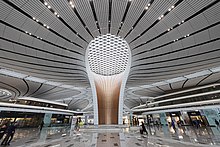

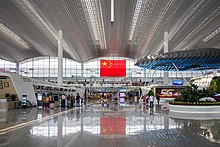
In 2007 China had 467 airports. Of China's major airports,Beijing Capital International Airport(PEK), located 27 km (17 mi) northeast of central Beijing, has the greatest flow of passengers annually and is the second busiest in the world.
Shanghai has the 2nd largest amount of air traffic in China through its two airports combined, theShanghai Pudong International Airport(PVG), which is located 30 km (19 mi) southeast of central Shanghai, andShanghai Hongqiao International Airport(SHA), which is located 13 km (8 mi) west of central Shanghai. Both are under control of the Shanghai Airport Authority.
The newGuangzhou Baiyun International Airport(CAN), which opened in August 2004 and is located 28 km (17 mi) from downtownGuangzhou.
Other major airports are located atHong Kong,Chengdu,Chongqing,Dalian,Hangzhou,Harbin,Hohhot,Kunming,Qingdao,Shenyang,Tianjin,Urumqi,Xiamen,andXi'an.
China is served both by numerous major international flights to most countries of the world and a host of domestic regional airlines. Air traffic within mainland China is often connected throughBeijing,ShanghaiorGuangzhou.They are, respectively, the main hubs forAir China,China Eastern AirlinesandChina Southern Airlines.In 2003 China'scivil aviationsector carried nearly 2.2 million tons of freight and 126.3 trillion passenger/kilometers.
Passenger flights toTaiwanand other places under administration of theRepublic of Chinamust followspecial rules.Flights between mainland China andHong Kong International Airport(HKG) andMacao International Airport(MFM) are considered international.[citation needed]
China, however, is planning to build a new airport inNagqu,Tibetin 2011. It will surpassQamdo Bangda Airportas being the world's highest airport once completed.[52]
Airports with paved runways
[edit]- Total: 403
- Over 3,047 m: 58
- 2,438 to 3,047 m: 128
- 1,524 to 2,437 m: 130
- 914 to 1,523 m: 20
- Under 914 m: 67 (2007)
Airports with unpaved runways
[edit]- Total: 64
- Over 3,047 m: 4
- 2,438 to 3,047 m: 4
- 1,524 to 2,437 m: 13
- 914 to 1,523 m: 17
- Under 914 m: 26 (2007)
Ports and shipping
[edit]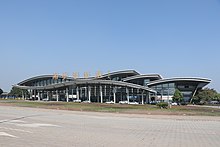
China has more than 2,000 ports, 130 of which are open to foreign ships. The major ports, including river ports accessible byocean-going ships, areBeihai,Dalian,Dandong,Fuzhou,Guangzhou,Haikou,Hankou,Huangpu,Jiu gian g,Lianyungang,Nanjing,Nantong,Ningbo,Qingdao,Qinhuangdao,Rizhao,Sanya,Shanghai,Shantou,Shenzhen,Tianjin,Weihai,Wenzhou,Xiamen,Yangzhou,Yantai,andZhan gian g.
China has sixteen "major" shipping ports with a capacity of over 50 million tons per year. Combined China's total shipping capacity is in excess of 2,890 million tons. By 2010, 35% of the world's shipping is expected to originate from China. The seven largest port terminals are Dalian, Guangzhou, Nanjing, Ningbo, Qingdao, Qinhuangdao, Shanghai. Additionally,Hong Kongis a major international port serving as an important trade center for China. In 2005 Shanghai Port Management Department reported that itsShanghai portbecame the world's largest cargo port, processing cargo topping 443 million tons and surpassingSingapore's port.ThePort of Shanghaiis presently undergoing significant upgrades. Shanghai Model Port Alliance is responsible for many of the upgrades that are expected to make Shanghai's port more automated, minimizing the loss of goods and time while helpingCustomscollect more accurate tariffs. If the Shanghai project is successful, there is interest in replicating the process in other Chinese ports.
In 2003 China's major coastal ports handled 2.1 billion tons of freight.

As of 2007, China's merchant fleet had 1,775 ships (1,000GTor over) 22,219,786GT/33,819,636 tonnesdeadweight(DWT) by type: barge carrier 3,bulk carrier415,cargo ship689, carrier 3,chemical tanker62, combination ore/oil 2,container ship157,liquefied gas35, passenger 8, passenger/cargo ship84,oil tanker250,refrigerated cargo ship33,roll-on/roll-off9, specialized tanker 8, vehicle carrier 17.
- foreign-owned: 12 (Ecuador 1, Greece 1, Hong Kong 6, Japan 2, South Korea 1, Norway 1) (2007)
- registered in other countries: 1,366 (Bahamas 9, Bangladesh 1, Belize 107, Bermuda 10, Bolivia 1, Cambodia 166, Cyprus 10, France 5, Georgia 4, Germany 2, Honduras 3, Hong Kong 309, India 1, Indonesia 2, Liberia 32, Malaysia 1, Malta 13, Marshall Islands 3, Mongolia 3, Norway 47, Panama 473, Philippines 2, Sierra Leone 8, Singapore 19, St Vincent and The Grenadines 106, Thailand 1, Turkey 1, Tuvalu 25, unknown 33) (2007)
Two importantrail ferrycrossings operate off the China coast. TheBohai Train Ferryallows freight trains to shortcut fromLiaoningtoShandong,while the Guangdong–Hainan Ferry (part of theGuangdong–Hainan Railway) connectsHainanIsland with China's mainland. There are also passenger and vehicle ferry lines connecting China withSouth Koreaand Japan, as well as with theR.O.C.-controlledKinmenIsland.
Waterways
[edit]
China has 127,000 kilometers of navigablerivers,streams,lakes,andcanals,[3]more thanany country in the world.In 2015, the traffic on the inland waterways has grown to 3.459 billion tonnes, cargo turnover to 1.331 trillion tkm. This is triple the volume since 2006. Passenger traffic is 271 million people and 7.308 billion person-km (2015), as reported by the 2015 Transportation Industry Statistical bulletin.

The main navigable rivers are theHeilong Jiang;Yangtze River;Xiang River,a short branch of the Yangtze;Pearl River;Huangpu River;Li gian g River;andXi Jiang.
Ships of up to 10,000 tons can navigate more than 1,000 km (621 mi) on the Yangtze as far asWuhan.Ships of 1,000 tons can navigate from Wuhan toChongqing,another 1,286 km (799 mi) upstream. TheGrand Canalis the world's longest canal at 1,794 km (1,115 mi) with the southern portion serving a key role in barge transportation betweenLiangshan Countysouth of the yellow river andHangzhou.It links five major rivers: theHaihe,Huai River,Yellow River,Qiantang,andYangtze.
Construction of new railways and highways has diminished the utility of China's rivers for passenger transport. Nonetheless, passenger boats are still popular in some mountainous regions, such as WesternHubeiandChongqing(theThree Gorgesarea), where railways are few and road access to many towns is inconvenient.
Pipelines
[edit]
As of 2006, China had 22,664 km (14,083 mi) ofgaspipelines, 15,256 km (9,480 mi) ofoil pipelines,and 6,106 km (3,794 mi) for refined products. Due to the growing dependence on oil and gas, the total length of oil and gas pipelines in China has risen to 70,000 km (43,496 mi) from 22,000 km (13,670 mi) in 1997, stretching from oil and gas fields in western and northeastern regions to densely populated coastal areas in the east. By the end of 2010, the network could exceed 90,000 km (55,923 mi).[53]
China's pipelines carried 219.9 million tons ofpetroleumandnatural gasin 2003. As a major oil and gas consumer, China is searching for more external supplies. Construction of a 4,200-km-long pipeline fromXin gian gtoShanghai(West–East Gas Pipeline) was completed in 2004. The government hopes that the use of natural gas will assist to reduce the use ofcoalwhich is responsible for muchair pollution.
Economic benefits
[edit]Some economic experts have argued that the development gap between China and other emerging economies such as Brazil, Argentina and India can be attributed to a large extent to China's early focus on ambitious infrastructure projects, notably mass transport and transit related projects. While China invested roughly 9% of its GDP on infrastructure in the 1990s and 2000s, most emerging economies invested only 2% to 5% of their GDP. This considerable spending gap allowed the Chinese economy to grow at near optimal conditions while many South American economies suffered from various development bottlenecks (poor transportation networks, aging power grids, mediocre schools...).[54]
See also
[edit]References
[edit]- ^Fengbo, Zhang.Economic Analysis of Chinese Transportation.
- ^China Statistical Yearbook 2016"Length of Transport Routes at Year-end by Region (2015)"Accessed 2017-02-16
- ^abc"Factbox: Highlights of China's comprehensive transport network - Xinhua | English.news.cn".xinhuanet.Retrieved2021-01-11.
- ^"China's high-speed rail tracks to hit 38,000 km by 2025- Xinhua | English.news.cn".news.xinhuanet.Archived fromthe originalon January 2, 2018.Retrieved25 April2018.
- ^abcd"Beijing's rail transit handles biggest passenger volume in China- China.org.cn".china.org.cn.
- ^"In response to growth, Chinese cities choose metros".The Transport Politic.2018-01-17.Retrieved2018-07-31.
- ^"Chinese highways for fast traffic add up to 65,000 km (40,389 mi) - Chinadaily".
- ^"About Us".Transport Bureau.Retrieved2023-06-03.
- ^ab(Chinese)2019 năm đường sắt thống kê công báo - 2019 Railway statistical bulletin
- ^""Mười ba năm" trong lúc cả nước đường sắt buôn bán chặng đường gia tăng đến 14.63 vạn km - trung tân võng ".chinanews.Retrieved2021-04-24.
- ^abc"Railway Statistical Bulletin for 2011".Ministry of Railway, People's Republic of China. Archived fromthe originalon February 18, 2012.RetrievedFebruary 15,2012.
- ^abc"China Infrastructure Trends".Vizala.Archived fromthe originalon 2016-08-16.Retrieved2016-09-13.
- ^"Rail lines (total route-km) | Data".data.worldbank.org.Retrieved2017-08-04.
- ^"Bus rapid transit in China: a comparison of design features with international systems"(PDF).Archived fromthe original(PDF)on 2017-12-10.Retrieved2018-04-25.
- ^Smith, Kevin."China Railway sets out 2017 targets".Retrieved2017-01-04.
- ^"China Exclusive: Five bln trips made on China's bullet trains - Xinhua | English.news.cn".news.xinhuanet.Archived fromthe originalon July 22, 2016.Retrieved2016-08-08.
- ^"China to start construction on 35 railway projects: report".Xinhua. February 19, 2017.
- ^"China puts nearly 2,600 high-speed trains into operation by 2016 - Xinhua | English.news.cn".news.xinhuanet.Archived fromthe originalon June 30, 2017.Retrieved2017-07-02.
- ^Dodson, Sean (15 January 2004)."Probably the world's fastest train".The Guardian.
- ^Marcus, Lilit (18 January 2021)."China debuts train prototype that can hit speeds of 620 kilometers per hour".
- ^"China unveils new 600 km/h ultra-fast maglev train".New Atlas. 21 July 2021.Retrieved21 July2021.
- ^ab"Chinese metro boom shows no sign of abating".International Rail Journal.November 19, 2014.Retrieved23 November2014.
- ^abArchived atGhostarchiveand theWayback Machine:"LONGEST UNDERGROUND NETWORK IN THE WORLD - SHANGHAI SUBWAY - BBC NEWS".YouTube.4 January 2014.
- ^"Statistics Brief World Metro Figures"(PDF).Union Internationale des Transports Publics (UITP) (International Association of Public Transport). October 2014.Retrieved2014-12-13.
- ^"Shanghai now the world's longest metro".Railway Gazette.4 May 2010.Retrieved9 April2014.
- ^"Trung Quốc 27 thành khai thông quỹ giao: Hoạt động đường bộ Thượng Hải dài nhất vì 579.2 km [ đồ ]- đường bộ chiều dài tốc độ mục tiêu giá trị hệ thống chế thức thị vực quỹ đạo giao thông xe điện có đường ray - Thượng Hải kênh - phương đông võng".Archived fromthe originalon 2021-03-08.Retrieved2018-05-12.
- ^"Reuters".Reuters.16 May 2016.
- ^Thành thị quỹ đạo giao thông 2016 niên độ thống kê phân tích báo cáo hoàn chỉnh ra lò.suilengea.Retrieved2017-07-16.
- ^"China Built a Self-Driving... Something".Popular Mechanics.2017-06-06.Retrieved2017-07-26.
- ^Wenhua, Wu (2–3 March 2005).Urban travel in China: Continuing challenges with rapid urbanization and motorization(PDF).Workshop on Implementing Sustainable Urban Transport Policies in Japan and other Asia-Pacific countries. Tokyo, Japan. Archived fromthe original(PDF)on 2015-06-24.Retrieved2015-06-24.cited inPlanning and Design for Sustainable Urban Mobility: Global Report on Human Settlements 2013(PDF)(Revised ed.).United Nations Human Settlements Programme (UN-Habitat).2014. p. 4.ISBN978-92-1-132568-3.Retrieved16 June2015.
- ^"Transport in Brazil".International Transport Statistics Database.iRAP.Retrieved2009-02-17.
- ^"Transport in China".International Transport Statistics Database.iRAP.Retrieved2009-02-17.
- ^"China to add and upgrade {{convert|270000|km|0|abbr=on}} of rural highway in 2008 - People's Daily Online".
- ^"China's Highway Network Expands to 74,000 Kilometers".ChinaAutoWeb.
- ^"Highway grid to be finished by 2015: MOT - People's Daily Online".English.people.cn. 2011-05-27.Retrieved2012-11-07.
- ^ab"China - Road Traffic Safety - The Achievements, the Challenges, and the Way Ahead"(PDF).openknowledge.worldbank.org.Worldbank. August 2008.
- ^"Road Safety in China: challenges and opportunities"(PDF).January 2008.
- ^Harper, Jo (2020-12-01)."Polish electric buses take over the European market".DW.Retrieved2023-11-27.
- ^Webb, Mary (ed.) (2011).Jane's Urban Transport Systems 2011-2012,p. "[23]" (in foreword). Coulsdon, Surrey (UK):Jane's Information Group.ISBN978-0-7106-2954-8.
- ^abcMurray, Alan (2000).World Trolleybus Encyclopaedia,pp. 8, 57 and 101. UK: Trolleybooks.ISBN0-904235-18-1.
- ^"Shanghai Anniversary" (Nov.-Dec. 2004).Trolleybus MagazineNo. 258, pp. 134–135.ISSN0266-7452.
- ^ab"China's Cyclists Take Charge", By Peter Fairley.Archived2009-05-11 at theWayback MachineIEEE Spectrum,June 2005
- ^abc"Cheap and green, electric bikes are the rage in China"Archived2013-01-12 atarchive.today,by Tim Johnson. Originally published 23 May 2007 by McClatchy Newspapers.
- ^"Europe's latest craze electric bikes"Archived2012-05-30 atarchive.today,Associated Press, 14 October 2008. The article givesChina Bicycle AssociationandXinhuaNews Agency's "Economic Reference" newspaper, as the sources of the numbers
- ^Susan Shaheen & Stacey Guzman (Fall 2011)."Worldwide Bikesharing".Access Magazine No. 39.University of CaliforniaTransportation Center. Archived fromthe originalon 2012-07-19.Retrieved2012-07-01.
- ^Mead, Nick Van (2017-03-22)."Uber for bikes: how 'dockless' cycles flooded China – and are heading overseas".The Guardian.ISSN0261-3077.Retrieved2017-05-20.
- ^Wang, Yue."Return of Bicycle Culture In China Adds To Billionaires' Wealth".Forbes.Retrieved2017-07-04.
- ^"China's bike-sharing boom in charts Trung Quốc nhấc lên xe đạp công nhiệt triều - FT tiếng Trung võng".ftchinese.Retrieved2017-07-05.
- ^Mead, Nick Van (2017-03-22)."Uber for bikes: how 'dockless' cycles flooded China – and are heading overseas".The Guardian.ISSN0261-3077.Retrieved2017-07-04.
- ^"The Runaway Bikeshare Boom in China Is a Cautionary Tale".Bicycling.2017-05-31.Retrieved2017-07-04.
- ^ab"China's fleet to double in five years".Archived fromthe originalon 2008-02-25.
- ^Mutzabaugh, Ben."Mileage calculator".USA Today.Retrieved2010-05-26.
- ^"China discusses draft law on the protection of oil and gas pipelines".2 November 2009. Archived fromthe originalon 2010-10-10.Retrieved1 July2011.
- ^M. Nicolas Firzli & Vincent Bazi (Fourth Quarter 2011)."Infrastructure Investments in an Age of Austerity: The Pension and Sovereign Funds Perspective".Revue Analyse Financière, volume 41..Archived fromthe originalon 17 September 2011.Retrieved30 July2011.
External links
[edit]- Ministry of Transport
- China Transporun by the Ministry of Transport'sTransport Technology Exchange Center
- China Academy of Transportation Sciences( giao thông bộ khoa học viện nghiên cứu ) (iicc.ac.cn)
- Transportation Information Center( giao thông tin tức trung tâm )
- Waterborne Transportation Institute
- China Ports and Harbors Association
- China Sustainable Transportation Center
- China Urban Sustainable Transport Research Center
- Beijing Transportation Research Center
- Shenzhen Research Center of Urban Transportation Planning
- Urban Transport Center, Ministry of Housing and Urban-Rural Development
- National Intelligent Transportation System Engineering Technology Research Center
- Urban Mass Transportation Research

